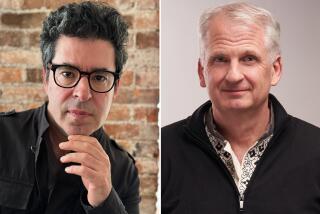Book review: ‘American Dreamers’ by Michael Kazin
American Dreamers
How the Left Changed a Nation
Michael Kazin
Alfred A. Knopf: 330 pps., $27.95
With “American Dreamers: How the Left Changed a Nation,” Michael Kazin tackles a conventional wisdom so deeply believed that even those it disparages tend to accept it — namely, that the history of the American left, for all its drama and artistry, brilliance and passion, is one of failure. It is, in that telling, a story of causes unfulfilled, elections lost, unions busted, communes dispersed. Kazin emerges with a counterpoint, not so much of hidden victories as of grand and enduring achievement, often carried to fruition by moderates but envisioned by the left and propelled by its energy.
It is, to say the least, a timely read.
Kazin is a lucid writer and a capable synthesizer, drawing together strands of politics, economics and culture across a broad sweep of American history. His narrative unearths the obscure contributions of Frances White, who urged her sexually integrated audiences to “turn your churches into halls of science,” and revisits the great works of Frederick Douglass and Elizabeth Cady Stanton in the overlapping causes of abolition and women’s suffrage. He describes the union leaders and rivalries that defined the early 20th century left, and he pays homage to the counterculture of the 1960s, including the iconic Tom Hayden (“Mickey,” one colleague reports after meeting Hayden, “I’ve just seen the next Lenin.”).
Finally, he comes loping to an ambivalent conclusion in modern times, when radicals seek an outlet for their intellectual energy and fret over the moderation of America’s first black president. Indeed, every half-wit who accuses President Obama of being a socialist should read this book, if only to discover what real ones look like.
Kazin’s ambition is to illustrate and argue, and he does both with exemplary skill. His sketches of the characters who populate his story are lively and illuminating. Eugene Debs, “the most popular messenger American socialism has ever known,” is described not only by his mission but his mannerisms, “stretching out his long arms as if to touch the crowds.” Ernestine Rose, a relatively obscure early feminist, fought for women’s right to own property and also invented an early deodorizer. And Kazin quotes Max Eastman’s unforgettable description of Bill Haywood, the towering figure of the International Workers of the World, forever known as the “Wobblies.” Haywood, according to Eastman, was “the arch-rebel, the one-eyed gigantic satan … prepared to storm the fortress of Capitalism with a proletarian army as soon as he could get one together.”
Such attention to detail makes reading Kazin’s book a pleasure, but it also is a work of honest rigor. Kazin understands the limitations of the left, its self-destructive divisions, its difficulty establishing an American presence within an international movement. To take just one example, the Wobblies are easy to romanticize — brawny field workers razzing capitalism — but Kazin characteristically resists. The IWW, he acknowledges, “was an organization of beautiful losers.” And no one has ever better captured the paradox of the Communist Party in America, which appealed to Americans only insofar as it was willing to distance itself from Marx, Lenin and Stalin and thus from its ideological roots. Kazin writes that to win followers at home, American communists “delayed and diluted their ultimate ends… Their success was also their failure.”
Kazin announces at the outset of “American Dreamers” that he’s prepared to engage in “forceful overstatement,” and he does not disappoint. In his zeal to credit the American left for its many forgotten or underappreciated achievements, Kazin puts his thumb on history’s scales. Thus, in his rendering, Thaddeus Stevens, John Brown and the militant abolitionists of the 19th century rate more credit and attention for their role in abolishing slavery than does Lincoln. That’s an imbalance, of course, but Kazin’s work is intentionally over-corrective and provocatively so.
My only real criticism of the book is in a sense a compliment. I would have enjoyed a more thorough examination of California’s role in the history of the American left — and of its critics. The labor clashes in early Los Angeles helped define not only California labor but also Los Angeles and the Los Angeles Times; sadly, those events, which culminated in the 1910 bombing of The Times, are not recounted here. Similarly, Emma Goldman and John Steinbeck appear in Kazin’s account, but there is no mention of Harry Bridges, the great organizer of West Coast longshoremen. Perhaps a second edition of “American Dreamers” will stitch those stories into Kazin’s larger history.
The left has never held power in the United States and thus can neither point to the accomplishments nor must answer for the atrocities of its compatriots elsewhere. And yet it is wrong, as Kazin demonstrates, to conclude from that that the left has been a failure. We are a freer and fairer country because of the work of abolitionists and suffragists, environmentalists and anarchists, Malcolm X and Martin Luther King. Some reached their goals; many more died trying. In some cases, the nation is lucky they failed. And yet, their mark is upon all of us.
As Max Weber, quoted in these pages by Kazin, observed: “Certainly all historical experience confirms the truth — that man would not have attained the possible unless time and again he had reached out for the impossible.”
Newton is The Times’ editor at large. His biography of Dwight D. Eisenhower, “Eisenhower: The White House Years,” will be published in October.
More to Read
Sign up for our Book Club newsletter
Get the latest news, events and more from the Los Angeles Times Book Club, and help us get L.A. reading and talking.
You may occasionally receive promotional content from the Los Angeles Times.











